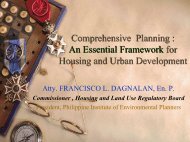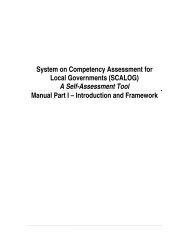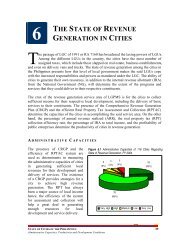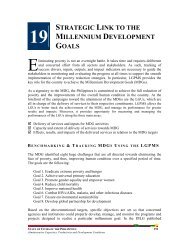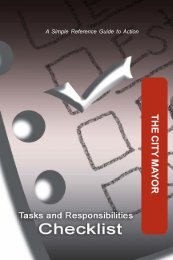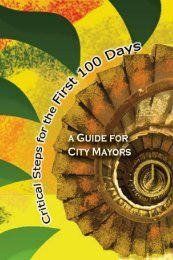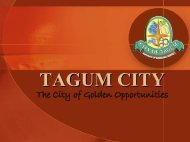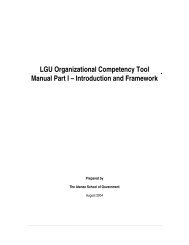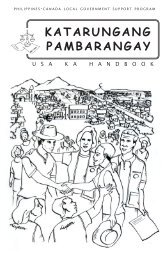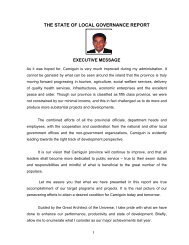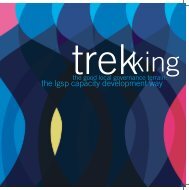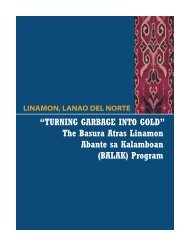Sigma 2005 - LGRC DILG 10
Sigma 2005 - LGRC DILG 10
Sigma 2005 - LGRC DILG 10
You also want an ePaper? Increase the reach of your titles
YUMPU automatically turns print PDFs into web optimized ePapers that Google loves.
Kasama Ka!: Multistakeholder Partnerships for Solid Waste Management<br />
SIGMA, CAPIZ<br />
Key<br />
Implementation<br />
Steps<br />
8. Ensure<br />
sustainability<br />
Expected Outputs<br />
• Continuous capacity<br />
building and IEC<br />
• Maintaining partnerships<br />
• Expansion beyond pilot<br />
sites<br />
Timeframe<br />
Continu<br />
ous<br />
Person/<br />
Agency<br />
Responsible<br />
SDFI with<br />
SWM Board<br />
Budget/ Resources<br />
Required<br />
• Personnel: 21 trained<br />
personnel to<br />
manage/operate the<br />
MRFs, including 7 paid<br />
eco-aides; volunteers<br />
• Commitment of<br />
members<br />
• Political will on the part<br />
of LGU leadership<br />
Analysis and Lessons Learned<br />
<strong>Sigma</strong>’s KASAMA KA program is an exemplary local government practice in<br />
managing solid waste that can be replicated by other LGUs facing a similar<br />
problem. The required resources for the program are reasonable for any 4 th<br />
class LGU, or even other LGUs with higher or lower income classification,<br />
especially since the scope and range of the program may be modified<br />
depending on the available resources and needs of the LGU. For example, an<br />
LGU with less financial resources or a smaller solid waste problem can pilot the<br />
program in a smaller area first, build a smaller MRF to save on costs and train a<br />
smaller number of personnel at the beginning of the program.<br />
Based on <strong>Sigma</strong>’s experience, however, there are some critical elements that<br />
help ensure successful replication:<br />
• The active commitment and effort of the LCE and the Sangguniang Bayan<br />
is vital to the success of the implementation of an ecological<br />
enhancement program.<br />
• Participation is key to success; therefore the utmost effort should be done<br />
to ensure that as many stakeholders as possible are involved and that all<br />
residents are educated and encouraged to participate in the program. The<br />
consultations conducted by <strong>Sigma</strong> made the program responsive to<br />
people’s needs; thus, people felt its impact on their lives. The<br />
consultations also made residents realize they themselves were major<br />
stakeholders, who were indispensable in making KASAMA KA! a success.<br />
Getting the support and cooperation of community organizations and<br />
NGOs such as SDFI was also critical in getting more public participation in<br />
the program. Effecting and sustaining an LGU-NGO partnership is also a<br />
noteworthy feature that other LGUs should seriously consider in<br />
undertaking a SWM program.<br />
• Communication and education plays an important role in facilitating<br />
participation and accountability. Massive Information, Education and<br />
Communication (IEC) activities are therefore indispensable to make<br />
October <strong>2005</strong> 15



